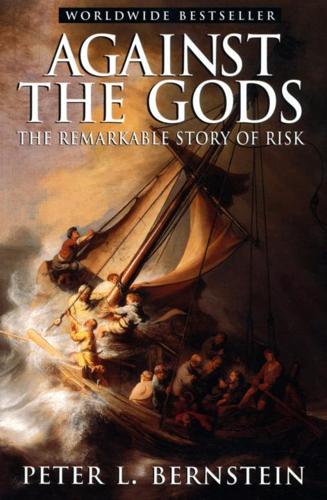
Against the Gods: The Remarkable Story of Risk
by
Peter L. Bernstein
Published 23 Aug 1996
At one point, Fermat believed he might have discovered a formula that would always produce a prime number as its solution, but he warned that he could not prove theoretically that the formula would always do so. His formula produced 5, then 17, then 257, and finally 65,537, all of which were prime numbers; the next number to result from his formula was 4,294,967,297. Fermat is perhaps most famous for propounding what has come to be known as "Fermat's Last Theorem," a note that he scribbled in the margin of his copy of Diophantus's book Arithmetic. The notion is simple to describe despite the complexity of its proof. The Greek mathematician Pythagoras first demonstrated that the square of the longest side of a right triangle, the hypotenuse, is equal to the sum of the squares of the other two sides.
…
In 1993, an English mathematician named Andrew Wiles claimed that he had solved this puzzle after seven years of work in a Princeton attic. Wiles's results were published in the Annals of Mathematics in May 1995, but the mathematicians have continued to squabble over exactly what he had achieved. Fermat's Last Theorem is more of a curiosity than an insight into how the world works. But the solution that Fermat and Pascal worked out to the problem of the points has long since been paying social dividends as the cornerstone of modem insurance and other forms of risk management. The solution to the problem of the points begins with the recognition that the player who is ahead when the game stops would have the greater probability of winning if the game were to continue.
…
Eric Temple Bell, one of Gauss's biographers, believes that mathematics might have been fifty years further along if Gauss had been more forthcoming; "Things buried for years or decades in [his] diary would have made half a dozen great reputations had they been published promptly."' Fame and secretiveness combined to make Gauss an incurable intellectual snob. Although his primary achievement was in the theory of numbers, the same area that had fascinated Fermat, he had little use for Fermat's pioneering work. He brushed off Fermat's Last Theorem, which had stood as a fascinating challenge to mathematicians for over a hundred years, as "An isolated proposition with very little interest for me, because I could easily lay down a multitude of such propositions, which one could neither prove nor dispose of."9 This was not an empty boast.
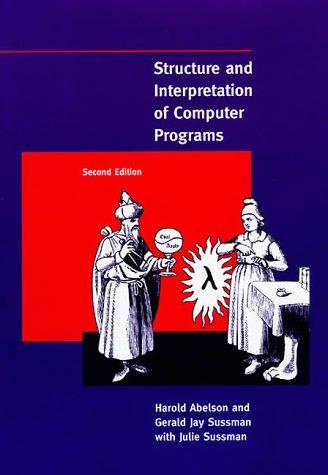
Structure and interpretation of computer programs
by
Harold Abelson
,
Gerald Jay Sussman
and
Julie Sussman
Published 25 Jul 1996
The first published proof was given by Euler in 1736 (and an earlier, identical proof was discovered in the unpublished manuscripts of Leibniz). The most famous of Fermat's results – known as Fermat's Last Theorem – was jotted down in 1637 in his copy of the book Arithmetic (by the third-century Greek mathematician Diophantus) with the remark “I have discovered a truly remarkable proof, but this margin is too small to contain it.” Finding a proof of Fermat's Last Theorem became one of the most famous challenges in number theory. A complete solution was finally given in 1995 by Andrew Wiles of Princeton University. 46 The reduction steps in the cases where the exponent e is greater than 1 are based on the fact that, for any integers x, y, and m, we can find the remainder of x times y modulo m by computing separately the remainders of x modulo m and y modulo m, multiplying these, and then taking the remainder of the result modulo m.
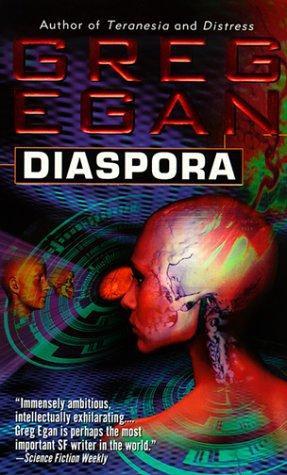
Diaspora
by
Greg Egan
Published 1 Jan 1997
"Exponential growth is a curse in all its forms. You know it almost wiped out the fleshers? If we were insane enough, we could try turning the whole planet-or the whole galaxy-into some kind of machine able to exert the necessary brute computational force . . . but even then, I doubt we'd reach Fermat's Last Theorem before the end of the universe." Yatima had persisted. "You could make the programs more sophisticated. More discriminating. Let them generalize from examples, form conjectures ... aim for proofs." Radiya had conceded, "Perhaps it could be done. Some fleshers tried that approach before the Introdus-- and if you're short-lived, slow, and easily distracted, it almost makes sense to let unthinking software find the lodes you'd never hit before you died.
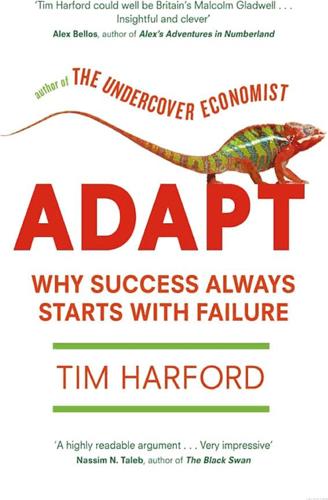
Adapt: Why Success Always Starts With Failure
by
Tim Harford
Published 1 Jun 2011
Christensen, The Innovator’s Solution (Harvard Business School Press, 2003), p. 198. 243 Whole structure of Virgin Group has always been: Richard Branson, Business Stripped Bare (Virgin Books, 2008), pp. 169–214. 244 ‘I’ll be damned if I permit’: anonymous officer quoted in John Nagl, Learning to Eat Soup with a Knife (University of Chicago Press, 2005), p. 172. 8 Adapting and you 247 ‘He was not a very careful person’: Shimura is quoted in ‘Andrew Wiles and Fermat’s Last Theorem’, MarginalRevolution.com, 29 August 2010, http://www.marginalrevolution.com/marginalrevolution/2010/08/andrew-wiles-and-fermats-last-theorem.html 247 ‘Let us try for once not to be right’: Tristan Tzara214. , 1918. 247 ‘Stupefyingly clichéd and almost embarrassingly naïve’: Hedy Weiss, ‘Good music, flashy moves can’t fill emotional void’, Chicago Sun- Times, 21 July 2002. 247 ‘Crazily uneven’: Michael Phillips, ‘“Movin’ Out”?

From Bacteria to Bach and Back: The Evolution of Minds
by
Daniel C. Dennett
Published 7 Feb 2017
There is not just coevolution between memes and genes; there is codependence between our minds’ top-down reasoning abilities and the bottom-up uncomprehending talents of our animal brains. And if our future follows the trajectory of our past—something that is partly in our control—our artificial intelligences will continue to be dependent on us even as we become more warily dependent on them. 101Simon Singh, “The Whole Story,” http://simonsingh.net/books/fermats -last-theorem/the-whole-story/, is by far the most accessible account I have found, an edited version of an essay published in Prometheus magazine. 102Watson, notably, does have some specialized self-monitoring layers: it must assess its “confidence” in each candidate answer and can also adjust its threshold of confidence, taking more or less risk in answering.

Antarctica
by
Kim Stanley Robinson
Published 6 Jul 1987
The home-conducting subculture was of course mostly uninterested in these overplayed warhorses of the concert hall, exactly the material from which computer conducting had freed them; and indeed Wade was coming to this piece from several years' work on unrecorded music in the opuses of D'Indy, Poulenc, and Martinu; but recently there had been movements, obviously related, to explore both "sensuous surface" and the neglected warhorses, and Wade felt that this performance he had put together was perhaps good enough to justify sending it out, at least to the Tchaikovsky crowd, the finale of the Fifth being somewhat in the nature of Fermat's last theorem, to which his version might be the Wiles proof. But there was the phone beeping. And of course it was Phil, Senator Philip Krishna Chase of California, his boss and friend, calling from the other side of the world and uncertain of the time difference as always. Phil had two years before lost the chair of the Senate Foreign Relations Committee, and was often spoken of as passe following the Republican retaking of both Senate and House that year; he had seldom been in Washington since (not that he had been here all that often before), and he appeared intent on proving that as the great telesenator he could do his job while on a more-or-less permanent junket/global pilgrimage (depending on who was characterizing it).

Coders at Work
by
Peter Seibel
Published 22 Jun 2009
Seibel: I haven't really done a study, but it seems like the vast majority of mathematical and scientific papers are typeset with TeX these days. There must have been things you've seen typeset in TeX that made you think, “Wow, my program played a part in this.” Knuth: Well, the proof of Fermat's Last Theorem was one of those. It's one of the most famous mathematical papers. And it happens all the time that I see books that I know wouldn't have been written if the authors had had to go through channels the way they used to. It's again a little bit of the black-box thing. It used to be, you would have to type something up and that would go into a compositor and it would come back in galley proofs, and so on.
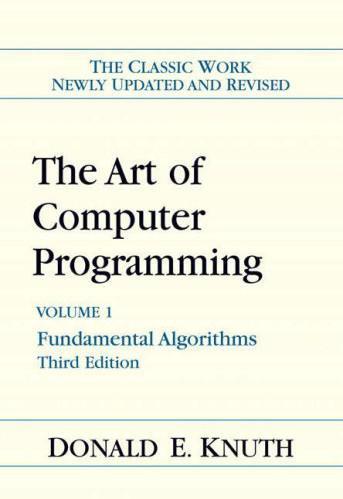
The Art of Computer Programming: Fundamental Algorithms
by
Donald E. Knuth
Published 1 Jan 1974
. — SHERLOCK HOLMES, in The Valley of Fear A888) ANSWERS TO EXERCISES / am not bound to please thee with my answers. Shylock, in The Merchant of Venice (Act IV, Scene 1, Line 65) NOTES ON THE EXERCISES 1. An average problem for a mathematically inclined reader. 4. See W. J. LeVeque, Topics in Number Theory 2 (Reading, Mass.: Addison-Wesley, 1956), Chapter 3; P. Ribenboim, 13 Lectures on Fermat's Last Theorem (New York: Springer-Verlag, 1979); A. Wiles, Annals of Mathematics 141 A995), 443-551. SECTION 1.1 1. t -f- a, a -f- b, b <— c, c <— d, d -f- t. 2. After the first time, the values of the variables m and n are the previous values of n and r, respectively; and n > r. 3. Algorithm F (Euclid's algorithm).

The Art of Computer Programming: Sorting and Searching
by
Donald Ervin Knuth
Published 15 Jan 1998
Be off, or I'll kick you down stairs!" LEWIS CARROLL, Alice's Adventures Under Ground A862) NOTES ON THE EXERCISES 1. An average problem for a mathematically inclined reader. 3. See W. J. LeVeque, Topics in Number Theory 2 (Reading, Mass.: Addison-Wesley, 1956), Chapter 3; P. Ribenboim, 13 Lectures on Fermat's Last Theorem (New York: Springer-Verlag, 1979); A. Wiles, Annals of Mathematics 141 A995), 443-551. SECTION 5 1. Let p(l). . . p(n) and q(l)... q(n) be different permutations satisfying the condi- conditions, and let i be minimal with p(i) ^ q(i). Then p{i) = q(j) for some j > i, and q(i) = p(k) for some k > i.